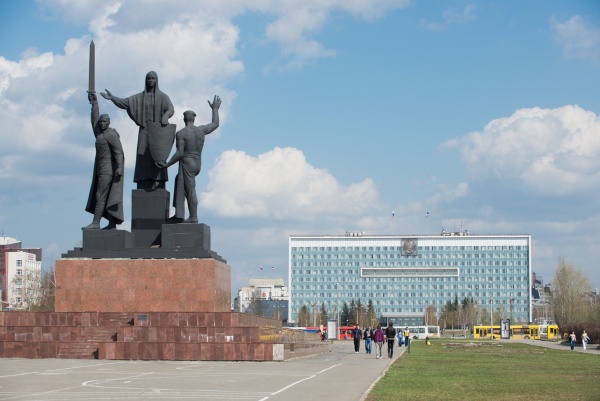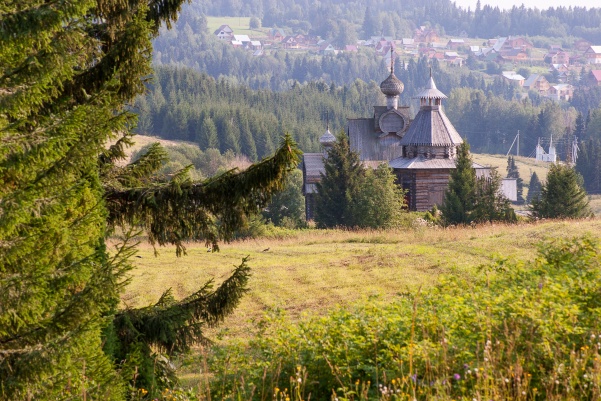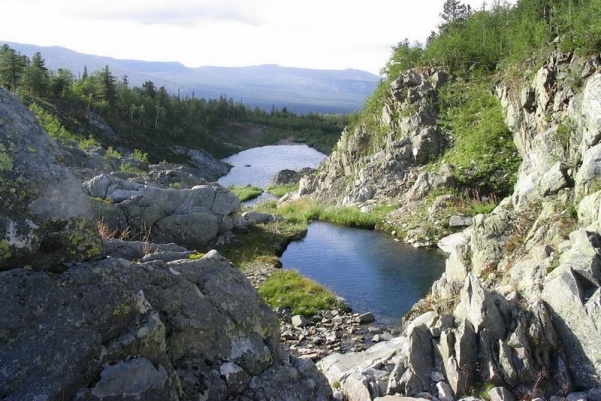Perm in Brief
Perm (Russian: Пермь) is a city and the administrative centre of Perm Krai, Russia, located on both banks of the Kama River in the European part of Russia near the Ural Mountains. According to the 2010 Census, Perm’s population is 991,162. The city is a major administrative, industrial, scientific, and cultural centre. The leading industries include machinery, defense, oil production (about 3% of Russian output), oil refining, chemical and petrochemical, timber and wood processing, and the food industry.
For centuries, Perm remained a gateway to Syberia. First mentioned as a settlement in 1647, it re-started its origins as a copper-melting plant since 1723, by Peter the Great. In the 19th century, Perm became a major trade and industrial centre for metal manifacture, paper, and steamboat production. In 1870, an opera theatre was opened in the city, and in 1871 the first phosphoric factory in Russia was built.
In 1916, Perm State University (PSU) —a major educational institution in modern Russia—was founded here. This decision of the Russian government met the initiative and strong support by the local community, acquiring to the strategy of social and economic growth of the Western Urals. Today, Perm serves a home for a dozen higher institutions. Historically, PSU had been a principal ‘mothership’ for many of those, gradually growing from the University faculties and research schools.


Perm Krai
Perm is the capital of a major territory – Perm krai, 160,600 km2 (62,000 sq mi). Perm Krai is located in the east of the East European Plain and the western slope of the Middle Ural Mountains. 99.8% of its area is in Europe, 0.2% in Asia. The krai borders the Komi Republic in the north, Kirov Oblast in the northwest, the Udmurt Republic in the southwest, the Republic of Bashkortostan in the south, and Sverdlovsk Oblast in the east. The krai borders stretch for over 2,200 kilometres (1,400 mi). The highest point is Mount Tulymsky Kamen at 1,496 metres (4,908 ft).
The Kama the city stands on is the main tributary of the Volga River, and is one of the deepest and most picturesque rivers of Russia. This river is the waterway which grants the Ural Mountains access to the White Sea, Baltic Sea, Sea of Azov, Black Sea, and Caspian Sea. The Kama divides the city into two parts: the central part and the right bank part. The city stretches for 70 kilometers (43 mi) along the Kama and 40 kilometers (25 mi) across it.
Climate and Related Activities
Ural winters here are snowy, with typical air temperatures from –10 to –25’C, but frosts down to –30’C are also not uncommon. February is marked by particularly strong winds. Skying and skating are the most popular ways to enjoy local winters, as well as visiting numerous ice-built ‘towns’ around the city. The ice sculpture lit by myriads of lights is a typical way to celebrate winter holidays.
In summer, the temperatures range from +15 to +25’C, and fall is quite warm and mostly dry. Perm Krai provides unlimited opportunities for summer outdoor activities, like rafting or hiking. Stretching along the Kama River, the history of Perm Krai is stored in numerous legends reflected in the names of cliffs, rocks and rivers.
Folk traditions might be discovered all the year around. The major local lore attraction remains the Khokhlovka Architectural and Ethnographic Museum. The International KAMWA Festival incorporates both traditional and modern fashion, crafts art and music, providing lots of new ideas and spaces for experimentation.


Time Zone
Perm, as well as the whole of Perm region, is in the time zone designated by the international standard as Yekaterinburg Time Zone (YEKT/YEKST). Displacement concerning UTC makes +5:00 (YEKT, winter time) and +6:00 (YEKST, summertime) as in this time zone transfer to summertime is in force. Concerning Moscow time the time zone has constant displacement +2 hours and is designated in Russia correspondingly as MSK+2.
Getting to Perm
Perm is a large transport hub. The city has especially advantageous geographical position as it is in the center of the country at the intersection of the railway from Europe to Asia (the Transsiberian railway) with the waterway of the submeridional direction to five seas.
The airport of “Bolshoye Savino” (Big Savino) is the “air gates” of Perm. Perm is connected with Moscow, Anapa, Krasnodar, Mineralnye Vody, Nizhnevartovsk, Norilsk, Samara, St.-Petersburg, Sochi, Surgut, Baku, Dushanbe, Yerevan, Frankfurt am Main and other cities by direct flights.
To get to Perm by plane, one may book a flight which lasts 2–2.5 hours and costs from RUB 9 000; and the prices for St. Petersburg flights start from RUB 13 000 (direct round-trip flight for one adult passenger).
One can reach Perm by train from Moscow in 20 hours (from RUB 6,000) or from St. Petersburg in one day (from RUB 10,000) (round-trip sleeper ticket for one adult passenger).
By car, the distance from Moscow to Perm is 1,400 km (19 hours), and a journey of 2,000 km from St. Petersburg takes a day.
Things to Do in Perm Krai
Rafting and fishing seasons start since the start of May. Hunting is allowed by license in the falls time. The wildlife is protected via a system of natural reserves, accessible strictly within research activities, serving a unique source for students in biology and Earth sciences. Prior to its popular industrial mission, Perm krai used to be a source for salt production, a place to search for and process natural minerals, including semi-precious and precious ones, as well as gold, copper and silver.
Perm is a great place to meet local crafts, both traditional and modern ones. The RAV Vast steel tongue drum was invented here recently by Perm craftsman Andrey Remyannikov. The instrument is a mixture of a tongue drum and a handpan, allowing rich harmonic overtones to resonate to the route note. The sound consequently has long sustain and reverberation.
While in Perm, tourists enjoy trying the local cuisine, like traditional potato-topped shanga pies, or posikunchiks mini meat pies; buying Perm animal-style amulets, or taking pictures in front of the big bronze bear – an ancient totem-related monument right in the city center. The must see is a world-known wooden sculpture, aka ‘Perm gods’, dating back to the 14th-17th centuries, a heritage of an older pagan tradition of worshiping wooden idols, and earlier – sacred animal amulets, metal-melted.
Festivals, Theatres, Museums
The Perm Opera and Ballet Theatre is considered as one of the best in Russia. There are many other theatres in Perm, including the “Teatr-Teatr” Drama Theater, the Puppet Theatre, the Theatre for Young Spectators, the “Scena Molot” Theatre, and the “U Mosta” (By the Bridge) Theatre . All the theatres are nationally acclaimed and involve international performances annually.
The Perm State Art Gallery is recognized for its outstanding collections of art, including paintings from 15th- 18th century art movements, and wooden sculptures from the region, housed in a 19th-century Orthodox cathedral. The spire of the museum towers over the rest of Perm, serving a landmark for the city. Presently Perm is getting considerable recognition due to the PERMM Museum of Contemporary Art, an exclave of the local ‘cultural revolution’, founded in 2009.
Perm is a home place for Sergei Diaghilev, and so, Russian ballet. The International Diaghilev Seasons Festival, as well as the Arabesque Ballet Competition are annual events, attracting a broad range of ballet dancer and lovers from worldwide. The Flahertiana International Documentary Film Festival serves a communication hub for many people involved in visual arts, demonstrating skills of carpe diem through characters and events taken from real life.
Globally Famous: Permian Period
Perm is world famous lending a name for the Permian geologic period and system which spans 47 million years from the end of the Carboniferous period 298.9 million years ago (Mya), to the beginning of the Triassic period 251.902 Mya – the last period of the Paleozoic era. The concept of the Permian was introduced in 1841 by geologist Sir Roderick Murchison, who named it after the region of Perm in Russia.
The Permian witnessed the diversification of the early amniotes into the ancestral groups of the mammals, turtles, lepidosaurs, and archosaurs. The world at the time was dominated by two continents known as Pangaea and Siberia, surrounded by a global ocean called Panthalassa. The Carboniferous rainforest collapse left behind vast regions of desert within the continental interior. Amniotes, which could better cope with these drier conditions, rose to dominance in place of their amphibian ancestors.
A Step into National History: Komi-Permians and Russians
The territory of the Perm krai had been settled already in the Paleolithic era. According to archaeological excavations, not only ferrous metallurgy was developed here, but also silver mines. Komis and Udmurts, the indigenous people, formerly known as Bjarmians, originally inhabited the land called Permia covering the middle and upper Kama River.
At the turn of the 1st and 2nd millenniums, the southern territories of the Perm Territory fell under the influence of the Volga Bulgaria, and then the Mongol-Tatar yoke. In the 3-6th centuries, the Perm Territory became part of the era of the great migration of peoples. By the 9th century the Udmurts came under the rule of the Tatars, the Golden Horde and the Khanate of Kazan until their land was ceded to Russia, and the people were Christianized at the beginning of the 18th century.
The Komis came under the rule of the Novgorod Republic in the 13th century, converted to Orthodox Christians in the 1360-1370s. In 1471-1478, remote Permian lands were conquered by the Grand Duchy of Moscow, later the Tsardom of Russia, with a support by river pirates, who defined themselves as Cossacks. In the 18th century, the Russian authorities opened the southern parts of Perm to colonization, while the northern parts served as an exile for criminals and political prisoners.


